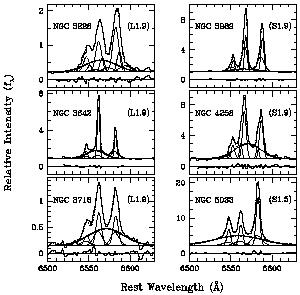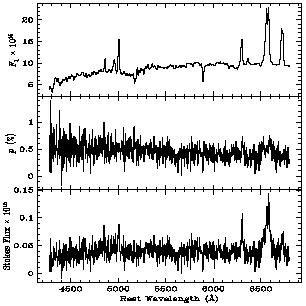


2.3. Detection of Broad-Line Regions
Bona fide AGNs such as QSOs and luminous Seyfert 1 nuclei distinguish
themselves unambiguously by their characteristic broad (FWHM ~ few
thousand km s-1) permitted lines which arise from the
broad-line region
(BLR). The detection of such broad lines in LINERs would constitute strong
evidence in favor of the AGN interpretation of these sources. Since the
strongest permitted line at optical wavelengths is expected to be
H ,
one of the primary goals of the Palomar survey was to search for broad
H
,
one of the primary goals of the Palomar survey was to search for broad
H emission. Of the sample of objects with broad
H
emission. Of the sample of objects with broad
H emission (22% of the AGN
candidates), more than half belong to the LINER category
(Ho et al. 1997b;
see Fig. 3). This is a very important finding,
because it implies that LINERs,
like Seyferts, evidently come in two flavors - some have a visible BLR, and
others do not. By direct analogy with the nomenclature established for
Seyferts, we might extend the ``type 1'' and ``type 2'' designations
to include LINERs. Approximately 15%-25% of the LINER population are LINER
1s, the appropriate fraction depending on whether the so-called transition
objects
(Ho et al. 1993)
are regarded as LINERs.
emission (22% of the AGN
candidates), more than half belong to the LINER category
(Ho et al. 1997b;
see Fig. 3). This is a very important finding,
because it implies that LINERs,
like Seyferts, evidently come in two flavors - some have a visible BLR, and
others do not. By direct analogy with the nomenclature established for
Seyferts, we might extend the ``type 1'' and ``type 2'' designations
to include LINERs. Approximately 15%-25% of the LINER population are LINER
1s, the appropriate fraction depending on whether the so-called transition
objects
(Ho et al. 1993)
are regarded as LINERs.

|
Figure 3. Decomposition of the
H |
A remaining, outstanding question, however, is what fraction of the
LINER 2s are AGNs. Again, by analogy with the Seyfert 2 class, surely
some LINER 2s must be genuine AGNs - that is, LINERs that happen to
have no BLR or have an obscured BLR. There is no a priori reason
why the
unification model, which has enjoyed such popular support in the context of
Seyfert galaxies, should not equally apply to LINERs. The existence of an
obscuring torus does not obviously depend on the value of the ionization
level of the line-emitting regions. If we suppose that the ratio of LINER 2s
to LINER 1s is the same as the ratio of Seyfert 2s to Seyfert 1s, that ratio
being 1.4:1 in the Palomar survey, we might argue that the AGN fraction in
LINERs may be as high as ~ 40%-60%.
What evidence is there, however, that the unified model is applicable to
LINERs? The faintness of the sources in question renders application of the
classical spectropolarimetric test (e.g.,
Antonucci and Miller 1985)
impractical for moderate-sized telescopes. An important breakthrough was
recently achieved by
Barth (1998),
who successfully used the Keck 10 m telescope to detect a polarized broad
H line in the prototypical LINER
NGC 1052 (Fig. 4). Weak broad
H
line in the prototypical LINER
NGC 1052 (Fig. 4). Weak broad
H wings were previously found in the
total-light spectrum after very careful profile decomposition
(Ho et al. 1997b),
but the broad line is undeniable in scattered light. Some LINER
2s evidently do harbor obscured BLRs. It would be highly desirable to
extend these observations to larger samples.
wings were previously found in the
total-light spectrum after very careful profile decomposition
(Ho et al. 1997b),
but the broad line is undeniable in scattered light. Some LINER
2s evidently do harbor obscured BLRs. It would be highly desirable to
extend these observations to larger samples.

|
Figure 4. Keck spectra of NGC 1052 from
Barth (1998).
Top panel - Total flux spectrum. Middle panel - Percent
polarization. Bottom panel - Stokes flux obtained from
F |
Lest one doubts that the existence of BLRs can be established with the detection of a single broad line, it should be remembered that broad lines are seen in other transitions as well, particularly in the ultraviolet (UV) where contamination by old stars poses less of a problem. The two best examples are M81 (Ho et al. 1996) and NGC 4579 (Barth et al. 1996) which were observed with the Hubble Space Telescope (HST). Finally, note that the minority of AGNs that display so-called double-peaked broad emission lines, whose origin is widely thought to lie in a relativistically rotating accretion disk, in fact very often exhibit LINER-like narrow-line spectra (Eracleous 1998 an references therein).